Some market observers have long argued that the mall is a relic of retail’s glory days. And as big-box stores continue to shutter across the U.S., proclamations about the mall’s slow-moving death march only ring louder. Yet a number of property developers are seeing this as an opportunity to transform their complexes into worthy e-commerce competitors. “We have to give the consumer a real reason to come into our stores, to get out of their cars and stay in our centers,” said Sandy Sigal, CEO and president of NewMark Merrill, an owner of malls throughout California, Colorado and Illinois. “This idea is old, but our centers got sloppy, as there wasn’t an alternative.” Malls are not exempt from the trend toward experiential services. At the Macerich Fashion District Philadelphia, the focus has been on filling a niche by implementing a new AMC theater and surrounding restaurants to serve the local community (no other such theater exists in downtown Philadelphia).
At Englewood Marketplace in Denver, owners have added a fitness center as well as new dining venues. With more square footage going toward services, that leaves less space for retail outlets. So who exactly are the tenants? While legacy ones are still in the mix, smaller brands and digitally native companies that meet the needs of the millennial and Gen Z shoppers — as well as their desire for genuine experiences — are driving the bulk of the action. “[Developers] want those retailers that have great product, great service and great experience,” said Doug Healey, EVP of leasing at Macerich. “The brands who just naturally do it well — because that’s who the millennials and Gen Z’ers grew up with — are the digital brands.
That’s why we’re doing deals with Allbirds, Untuckit, Morphe and Peloton.” These leases also benefit the e-commerce companies looking to enter the brick-and-mortar market due to the large volume of foot traffic and exposure they gain in these locations. Studies continue to show that shoppers prefer the in-store experience to buying online, so having a physical store is a valuable investment. For developers, it always comes back to demand. Unfortunately, not all of the malls will be able to survive; the International Council of Shopping Centers reports that 20 percent of malls bring in over 72 percent of the revenue. This makes it increasingly important to pinpoint the particular market needs in a location and adjust accordingly — before local competition is able to. For real estate brokerage and investment firm JLL, that has meant elevating the Manhattan Village center in Manhattan Beach, Calif., into a luxury destination. “The timing was right to add a modern luxury look and feel,” said Don Ziss, senior GM. “We think the market is ready for chef-driven cuisine, first-to-market retail brands and outdoor lifestyle elements that pair well with the sunshine of Southern California.
There will be separate designated valet and Rides-hare locations.” If a complete redesign isn’t sustainable, then a considered assessment of merchandise mix could still mean the di fference between a busy mall and an empty one. At Mission Marketplace in San Diego, NewMark Merrill identified that it was losing shoppers to a competitor across the street. By studying the demographic and replacing the local chain grocery store with a Sprouts and the Kmart with a Target, the property was able to reclaim its “who’s who of retailers” status for the neighborhood. A developer might also look to open a concept within a property, such as the clusters of pop-up stores that are found at Neighborhood Goods, Fourpost and Macerich’s own Brandbox. The revolving nature of the tenants ensures a varied product mix and experimental activations. In a similar move, JLL recently opened Rose & Loon at Rosedale Center in Roseville, Minn., a space dedicated to selling local wares in a boutique like environment.
“It’s a great complement to what we have in the shopping center,” said Healey. “These are brands that aren’t represented in our centers, so a lot of the business is very accretive. It’s something that is nontraditional, that our new shopper wants and likes.” And it’s mutually beneficial: While brands can test physical retail with lower risks, the shopping centers can continually provide something new for their market. As malls shift from pure shopping environments to community centers, developers are conscious of keeping their customers engaged. “I love those projects — I think that’s the way forward,” said Sigal. “The modern center will be like a museum, with standard exhibits and revolving exhibits: your ‘anchor’ stores and your seasonal or temporary stores.”
Original Article – FN Insights: Real Estate
Author: Madeleine Streets
